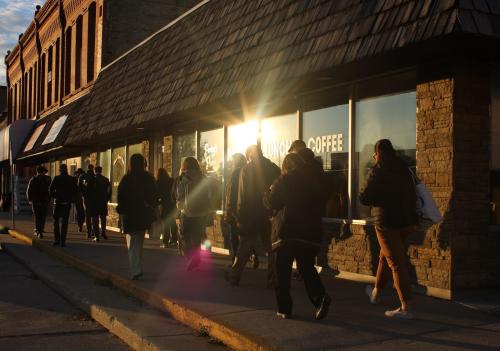Last week’s data from the Census Bureau on poverty and income provided some hints as to the impact of the Great Recession in U.S. regions and metropolitan areas. The picture becomes clearer today with the release of data from the 2010 American Community Survey. They portray a bleak period in metro areas that swelled the ranks of the poor and punctuated a decade of economic stagnation for the middle class. Here are five trends that stood out to us in an initial scan of income and poverty data for the nation’s 100 largest metro areas:
The Great Recession raised poverty rates and reduced household incomes in the vast majority of metro areas. The deep downturn left relatively few places untouched. Among the 100 largest metro areas, poverty rates rose in 79, and median household incomes declined in 82, between 2007 and 2010.
Nearly all large metro areas ended the decade with lower median incomes than in 2000. From 2000 to 2010, incomes declined in 91 of the 100 largest metro areas, and poverty rose in 88. In many, the recession merely exacerbated a negative pre-existing trend. In the first seven years of the decade, median household income fell in 70 metro areas, and poverty rates rose in 48. Census 2000 captured U.S. households at a high-water mark economically, a far different situation than they faced in 2010, or even before the Great Recession began.
Large poverty increases brought on by the Great Recession began in housing-bust and manufacturing-oriented metro areas, but subsequently spread to other places in the South and West. Over the first two years of the downturn, Sun Belt metro areas on the front lines of the housing market collapse—in Florida, the Intermountain West, and inland California—registered the largest increases in poverty rates. They were joined by a handful of metro areas in the nation’s manufacturing belt like Indianapolis and Cleveland. Several of these places continued to experience rising poverty from 2009 to 2010, but the most affected places included a broader set of metro areas in the Southeast like Columbia, Birmingham, and Nashville; in other parts of the West like Salt Lake City and Colorado Springs; and in previously better-off regions like Austin and Omaha.
The recession increased overall poverty rates in cities and suburbs by similar degrees. From 2007 to 2010, the poverty rate in major-metro cities rose 2.9 percentage points, compared to 2.3 percentage points in suburbs. Older Northern regions like Akron, Baltimore, New Haven, and Rochester tended to experience much larger increases in city than suburban poverty, while some Southern and Western regions like Oklahoma City, Orlando, and Seattle saw poverty rates rise more in suburbs than cities. Overall, the poverty rate in cities (20.9 percent) remained far higher than that in suburbs (11.4 percent) in 2010.
Poor populations continued their decade-long shift toward suburban areas. A combination of factors including overall population growth, job decentralization, aging of housing, immigration, region-wide economic decline, and policies to promote mobility of low-income households led increasing shares of the poor to inhabit suburbs over the decade. From 2000 to 2010, the number of poor individuals in major-metro suburbs grew 53 percent, compared to 23 percent in cities. In 16 metro areas, including Atlanta, Austin, Dallas, Indianapolis, and Milwaukee, the suburban poor population more than doubled during that time. The recession merely served to accelerate the trend, as suburbs added 3.4 million poor from 2007 to 2010—1.4 million more poor individuals than cities.
Meager job growth and unemployment rate declines over the past year seem sure to extend many of the worrisome trends portrayed in the new data. As always, though, metro areas will chart distinct trajectories amid a sluggish national recovery. Can any manage to grow in ways that actually benefit low- to middle-income families? And knowing that things are likely to get worse before they get better, can metro areas adapt a traditionally city-focused social services infrastructure for helping the poor to the reality of increasingly region-wide needs?
The Brookings Institution is committed to quality, independence, and impact.
We are supported by a diverse array of funders. In line with our values and policies, each Brookings publication represents the sole views of its author(s).



Commentary
Parsing U.S. Poverty at the Metropolitan Level
September 22, 2011